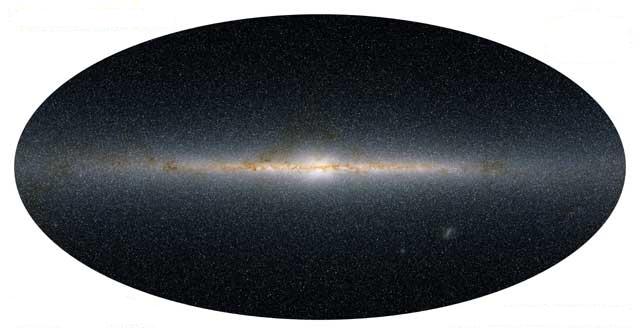
Looking into our Milky Way
Credit NASA
Stars "hang out" in galaxies. Our sun (along with 200 billion other stars) makes up our home galaxy called the Milky Way. Perhaps you've seen the Milky Way (best seen in the summer months), and wondered what it was. It is difficult to picture our Milky Way because we are viewing it from the "inside". It is similar to asking a person to describe their house if they have only been in one room the whole time. There is so much gas and dust blocking our view that it is like trying to look into fog. Fortunately, astronomers have some great tools, and there are many other galaxies we can see, ... and this helps us understand the properties of our own galaxy much better.

Looking into our Milky Way
Credit
NASA
Looking at the image above, and you can see that the Milky Way is flat. This is known as the galactic disk, and it consists of stars, gas, and dust. The panoramic (above) shows that this flat band forms a complete circle in the sky, but the central region is by far the brightest. This bright region is found near the constellation Sagittarius (which from Wisconsin is seen in the late summer in the southern sky). At the turn of the last century, very little was known about nature of this structure. Its size, exact shape, makeup, and the sun's location in this huge structure was very much a mystery.
The mystery started to unfold in 1916-1917 when Harlow Shapley made a survey of globular clusters in the sky. A globular cluster is a tight grouping of old stars which usually contain about 100,000 individual stars (some contain up to 10 million stars). Click to see some images of globular clusters - M3, M13, M55, and Omega Centauri.
Shapley found that most globular clusters are concentrated on either side of the Milky Way in the direction of Sagittarius (the brightest part of the band). This led him to believe that these clusters were actually part of the Milky Way structure itself. He also concluded that the center of the Milky Way was in the direction of Sagittarius because he felt that globular clusters orbit close to and around the center of the Milky Way (which they do). By using Cepheid variables, Shapley tried to find the average distance to these globular clusters. Today, astronomers believe we are about 27,000 light years from the center of the Milky Way (a value only slightly smaller than the one calculated by Shapley).
Modern astronomers are able to map our own galaxy because hydrogen (the most abundant gas) emits radiation at 21 centimeters (which radio astronomers analyze along with Doppler data) to show that most of the hydrogen is concentrated in great structures (called spiral arms). These arms are located far from the center of the Milky Way (along with the sun). These arms are also the birthplace of new stars (as discussed in a previous unit).
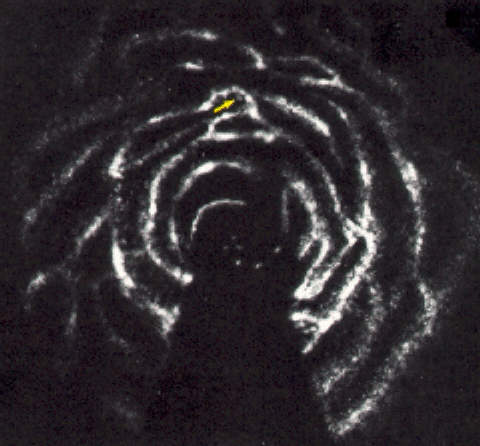
A 21 cm view of our galaxy (we are at the yellow arrow)
The Milky Way is a spiral galaxy (actually it is a barred spiral galaxy), and the solar system is in one of the spiral arms (Orion Arm). It mostly flat ... roughly the shape of a fried egg in a frying pan. We are in the plane (called the galactic disk) of the Milky Way, but far from its center (see arrow). The visible part of our Milky Way is about 100,000 light years in diameter and contains about 200 billion stars. There are several small groups of stars ... known as globular clusters which orbit around the Milky Way (and concentrated towards the center). The galaxy spins, ... taking about 225 million years for the sun to make one trip around the center.
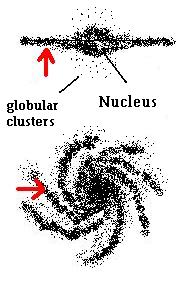
Spiral arms are something of a mystery. Earlier astronomers wondered how they could exist at all. It was felt that, in time, they would coil themselves up (like a watch spring which is wound tighter and tighter) as the galaxy rotated. In our solar system, planets close to the sun orbit much faster than the outer planets. It was always assumed that stars in our galaxy would behave much the same way. That is, stars close to the center of the Milky Way would orbit faster than stars farther out. However, that was not the case in our galaxy (and other spiral galaxies). Stars near the outer edge were found to be moving much faster than expected. This introduces a new mystery, namely, why does it do this? We will come back to this problem later, but this fact helps explain the arm problem.
|
The galaxy spins, .. but why don't the arms "wind up"? (animation) |
Watch the moving red dot! (animation) |
One theory which explains spiral arms is called the Spiral Density Wave Theory. If enough mass is concentrated in the spiral arms, it acts like a local "gravity well", a region of high local gravity. Now, suppose that stars are not permanent members of any particular arm, but rather, move from one arm to the next. As they approach an arm (from behind), they are attracted to it (by gravity), and once in the arm itself, they slow down, and remain in the arm for a longer time. In the process, they add to the collective mass of the arm (which helps perpetuate the wave). Once they leave the arm, they speed up and move to the next arm. This is depicted in the animation above. In a nutshell, this theory claims that individual objects move faster than the arms themselves, but slow down once they encounter an arm. A similar analogy can be found as you drive on a toll road. Cars slow down as they approach the toll booth, and then speed up once they pay their money, ... only to slow down as they get to the next toll booth. If you were to watch the booth from a helicopter, you would always find a concentration of cars at that same place.
Spiral arms are also the place where gas and dust concentrate and act as stellar nurseries. As new stars are being born, dying stars are expelling gas and dust into space for another generation of stars. Shock waves from supernovae explosions help concentrate dust into nebulae and also aid in the collapse of the nebula itself (until gravity takes over). Each time a type II supernovae goes off, it adds to the concentration of heavier elements in the region. Spiral arms and supernovae are essential to our existence.
Is our Galaxy "warped"? In 2019, astronomers suggested that the disk of our Milky Way is "warped". A new distribution map of 1339 Cepheid variable stars in the galactic disk implies that the disk may look like a vinyl record left out in a hot car!

Does our galactic disk look like this?
Our Milky Way has a high concentration closely packed stars in the central bulge (also known as the nucleus). The very center of our Milky Way holds a supermassive black hole (designated Sagittarius A* - pronounced “Sagittarius A-star”). Although its mass is far below the value found in other galaxies, any black hole with a mass of several million solar masses has to sound impressive. Recently astronomers discovered stellar mass black holes lurking in the center of our galaxy in the vicinity of Sgr A*. All were discovered because they had a visible binary companion. This suggests there may be thousands of stellar mass black holes in this region. Story here.
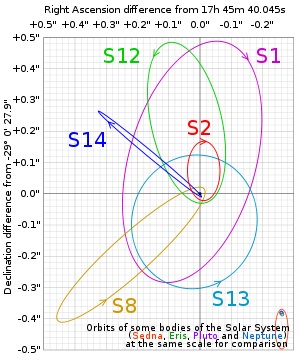
The orbits of several stars around the supermassive black hole (Sgr A*) in the nucleus of our galaxy.
Surrounding our entire visible galaxy is a region known as the halo. The globular clusters are found in the halo. Globular clusters contain many closely packed, old, metal poor stars. By metal poor, I mean that this region lacks the concentration of higher elements on the periodic table. The halo is also the home of one of the biggest mysteries in astronomy, ... dark matter (and lot of it). We cover dark matter below.
|
Spiral Galaxy NGC 1232 |
NGC
1365: A Nearby Barred Spiral Galaxy (like our own Milky Way) |
Credit: FORS1, 8.2-meter VLT Antu, ESO
Edwin Hubble studied galaxies in the 1920's and noted that they come in many shapes and sizes. He wondered whether they were a part of the Milky Way, or independent and isolated structures. He soon concluded that these objects are not connected to our Milky Way, and the term "island universes" was often used to describe them. This conclusion give astronomers a great tool for studying our own Milky Way. If we could learn more about other galaxies, it will help us discover the secrets of our own Milky Way as well. It also humbled us a bit to learn that our Milky Way is just one of many, many others in this universe.
He classified galaxies into three groups:
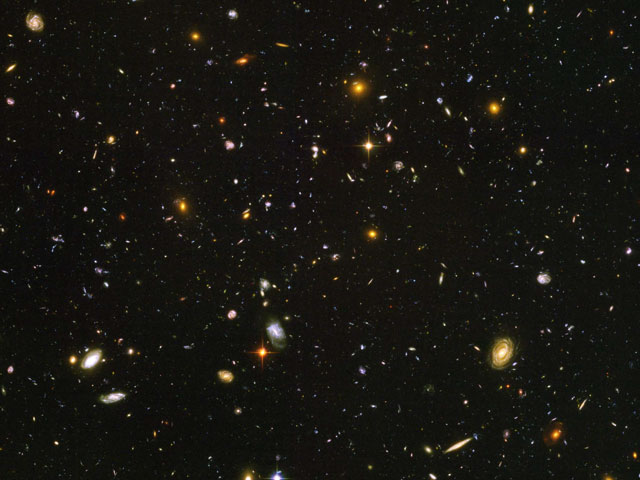
The Hubble Ultra Deep Field
Credit: S.
Beckwith & the HUDF Working
Group (STScI), HST, ESA, NASA
Certainly there are many, many, many galaxies! (Wow! ... and each one has billions of stars.) The problem is .... every time someone builds a better telescope, astronomers find more galaxies!!!! To illustrate the point, the Hubble Ultra Deep Field scope took long time lapse exposures of areas of the sky that seemed empty. The results showed a rich field of distant galaxies. The picture above shows one of those images. This image represents just a very small section of the sky (like looking at a fly from across a football field). Each dot in the image above is not a star (in our own galaxy), ... it is a galaxy itself. If this doesn't impress you, nothing will.
2018 update: The estimated number of galaxies in the visible universe has been increased to two trillion!!!!
The Milky Way is part of a gravitationally bound group called the local group. It consists of a few dozen galaxies (the number in 2020 rose to 54) including 3 spirals, a few irregulars, and mostly small elliptical galaxies.

Galaxies within a group are gravitationally bound to the group (animation)
When we look out into distant space we see a lot of galaxies, but they are not evenly distributed. Galaxies tend to lump together into groups. Groups of galaxies tend to lump together to form clusters. Our local group is relatively close to the Virgo Cluster. Other common examples are the Perseus cluster and the Hydra Cluster. Clusters of galaxies tend to lump together to form superclusters. The Milky Way is a member of the Virgo supercluster. Space is also filled with cosmic voids (places with little or no galaxies).
Now that's an interesting question. Imagine how surprised you would be if you stood on a bathroom scale one day, and it said your weight was over a ton! That is exactly the situation astronomers were put in when they studied the dynamics of galaxies. When we look at galaxies we see stars, gas, and dust (at least in spirals), but the physics tells us we are only seeing an estimated 20% of the mass of a galaxy. Astronomers are convinced that galaxies have much more mass than they can presently see ,... and they don't have a clue what form it takes. This is based on several clues.
This "hidden matter" is known as dark matter, and it may make up over 80% of the mass of the universe! What form could this matter take? Possible answers are:
One of the greatest discoveries in astronomy was made by Edward Hubble in the late 1920's. He discovered that the universe is expanding! Hubble was looking at galaxies and noticed (with a few exceptions) they all showed Doppler red shifts (receding from us). Hubble was not aware of galactic clustering. Today, we know this rule does not apply to galaxies within our local group of a few dozen galaxies. However, when we look at all the other galaxies in the universe ... they all appear to be moving away from us! In fact, the farther a galaxy is from us ... the faster it appears to be receding from us. Stated in other words, galaxies closer to us are receding from us slowly, however, galaxies farther from us are receding from us at greater speeds. This is now known as Hubble's Law or the Law of Redshifts. Of course, it comes from observing the Doppler effect as Hubble examined the spectral lines of distant galaxies.
Don't think that this implies that the Milky Way is the center of the universe. An observer viewing the universe from any galaxy would make the same observation. Imagine you place dots on a balloon and then add air to the balloon. If each dot represents a galaxy, then no matter which dot you observe from, ... you would make the same conclusion, ... and that is, ... everything appears to be moving away from you!
Einstein was working out the behavior of the universe in his Theory of Relativity, which he saw as collapsing under gravity. His gut reaction (and the prevailing thought at the time) was that the universe should be static so he "fudged" his equations so it wouldn't contract under gravity (with a term he called the "cosmological constant"). This term acted like an "anti gravity" force which balanced gravity and kept the universe static. When Hubble demonstrated the expanding universe there was no longer a need for a cosmological constant. Einstein dropped the number from his equations, calling it the "greatest blunder in my life". Oddly enough, astronomers are discovering a "repulsive force" which requires the re-introduction of the cosmological constant. Maybe Einstein was not so wrong. Stay tuned.
To demonstrate the expansion of the universe, early astronomers introduced a term called the Hubble constant, Ho. This value is an attempt to determine the expansion rate of the universe. It assumed that the expansion is uniform in time (which is not true, actually). The best estimate for the Hubble constant ( H0 ) is 73.5 km/sec/Mpc (kilometres per second per megaparsec) for nearby galaxies but only 67 km/sec/Mpc obtained in 2013 by the Plank Telescope. That is, for every million parsecs (3.26 million light years) a galaxy is from us, it recedes at a speed of 67 km/sec. The fact that astronomers get two values for something that was once assumed to be a constant tells us that the rate of expansion IS, indeed, changing with time.
Obtaining an accurate value for the Hubble constant would help astronomers in many ways. For example, it can be used to estimate the distance to a galaxy from its red shift (which is easily obtained). Let's assume a value of 73.5 km/sec/Mpc (kilometres per second per megaparsec) for the Hubble constant. If an astronomer finds that a galaxy is receding with a speed of 1000 km/sec, they could estimate that the galaxy is about 13.6 million parsecs from us (1000 ÷ 73.5). If numbers scare you, just remember, bigger red shifts imply greater distances. This is precisely how astronomers estimate the distance to quasars. Quasars have such huge red shifts ... so they must be very distant.
Another reason an accurate value for the Hubble is needed is to determine the age of the universe. If we know the expansion rate of the universe, we can work backwards to find the time when everything was all in one place - the Big Bang.
We know that galaxies formed very early in the history of the universe, but the mechanics remains a mystery. If we had better tools, perhaps we could just observe it. The James Webb space telescope will do just that. However, these events happened about 13 billion years ago, so we would need a telescope that could see details 13 billion light years away. So far, the record is sketchy. We don't know why some galaxies turn into spirals and other form elliptical galaxies. One possible answer depends on whether stars within the developing galaxy form all at once (elliptical) or stagger their formation over time (spiral). Perhaps spiral arms form as a result of gravitational perturbations with nearby giant molecular clouds? The answer still eludes us. Maybe you will find the answer!
When you look farther in space, you are looking back in time as well. Astronomers look toward deep space (distant past) and see a few things. In the distant, early universe there were:
This implies that galaxies change with time. Specifically, galaxies merge and as time progresses we observe less low mass galaxies, less galaxies in any given volume of space, and the number of spiral galaxies are disappearing as the universe ages.
Hubble felt that galaxies "evolve" from one type to another. Although his scheme was wrong, ... his idea was correct. Galaxies within a group can interact (gravitationally) in ways that alter their shape and appearance. In fact, galaxies can have head-on collisions and a smaller galaxy can be cannibalized by a larger one. Two or more galaxies can merge together, forming one single large galaxy. This is because galaxies are rather large compared to their average separation, and they move randomly within groups, which invite collisions and close gravitational tidal encounters. Astronomers have found many examples of galaxies in the process of collision. When it happens, it triggers an intense period of star formation as gas (within the galaxies) is compressed during the event. Additional evidence of galactic mergers comes from observing that most large galaxies contain a supermassive black hole. However, several galaxies have been discovered with two supermassive black holes ... suggesting an earlier merger between two separate galaxies.
For example, the Magellanic Clouds are irregular galaxies because of close gravitational encounters with the Milky Way. Tidal forces may be ripping them apart and/or a recent close passage through our halo may have altered their shape. Eventually both the LMC and the SMC will be swallowed up by the Milky Way. Another dwarf elliptical galaxy (Sagittarius Dwarf Spheroidal Galaxy) is currently being eaten alive by gravitational tidal forces from our Milky Way. Our Milky Way galaxy has a long history of swallowing up the little guys. Evidence comes from "streams" left behind from the mergers (Gaia Sausage & Helmi stream, for example).
Models show that collisions between spiral galaxies can "convert" them to a class known as lenticular galaxies. This type of galaxy is somewhere between spiral and elliptical galaxies! Perhaps the result of such galactic collisions is one huge elliptical galaxy? If that is the case, we may be in trouble. The Andromeda galaxy (a spiral slightly larger than the Milky Way) is heading straight toward us, ... like two trains on the same track. The local group has only 3 spiral galaxies in it. After this collision, these two large spirals may merge, ... forming one huge elliptical galaxy. Then there will only be one spiral galaxy left in the local group, ... the Triangulum galaxy.
But hope is not lost for spiral galaxies. Recent computer models have shown that there may be a way to make spiral galaxies from the tidal interaction between two passing elliptical galaxies. The animation below shows one possible way a beautiful galaxy called the Whirlpool galaxy (M57) may have formed. Astronomers need much more data to confirm this possibility.

Can two elliptical galaxies make a spiral? (animation)
In the first billion years of our universe there were lots of small galaxies ... perhaps ten times the number right now. Galactic numbers dropped as small low mass galaxies merged to form fewer massive galaxies. However, getting observations from times earlier are extremely difficult since it is hard to see things over 13 billion light years away. Maybe that will all change when the James Webb telescope goes into action. This next generation space telescope will be able to see that early universe because (unlike the Hubble telescope), the James Webb scope will have eyes in the infrared. Perhaps you already know this (but will surely learn soon), our universe is expanding. This expansion also effects the light coming from distant galaxies. Remember the Doppler red shift? Light from very early galaxies is shifted to the infrared by the time it reaches us so we need a tool like the James Webb telescope to answer questions like: How do galaxies form in the first place? What factors determine if a galaxy starts out as a spiral or elliptical? How many galaxies are there? I can't wait!
©Jim Mihal 2004, 2014, 2018, 2020 - all rights reserved